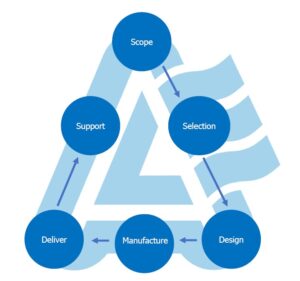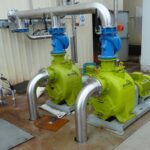At Allflo Pumps & Equipment, we take safety very seriously. In fact, it’s our number one priority and after 70 years in the pump business we’ve learnt a thing or two about safety regarding pumps. Here we want to share with you a number of important safety aspects concerning pumps and pumping systems.
Before you visit a site
Prior to visiting a pump installation onsite, PPE (Personal Protection Equipment) should always be your first consideration and as a minimum usually involves:
- Hard Hat (Ensure it’s within expiry date and nil damage – if you drop it replace it)
- Steel Capped Boots (Consider acid and static resistant soles along with zipped high sides for ankle protection, support and easier removal)
- Hearing Protection (earmuffs or disposable earplugs – make sure they are the correct rating for task)
- Long sleeves and long pants
- Fluorescent Coloured Safety Vest with Reflective Stripes
- Leather Gloves
The risks to consider
Of course, it is essential to be careful of hazards when dealing with any type of tools or equipment. However, in our opinion pumps in particular have multiple potentially hazardous risks to be mindful of.
- Moving Parts: Pumps have many rotating or reciprocating components such as shafts, pulleys, fans, impellers, drive belts, drive chains and couplings. Even when guarded or shielded correctly, these present amputation and/or entanglement risks. Australian standard AS4024 exists for the safe guarding of pumps.
- Electricity: One of the many means of driving a pump is via an electric motor. These can be quite small, for instance 0.25 kW and 240 Volts. Alternatively, they could be much larger at 250 Kw and 415V or even some power station cooling pumps with four motors totalling 18 MW with an 11,000V power supply.
- High Pressures: When in operation, pump casings contain elevated pressures and these should always be considered highly hazardous. The same can be said of discharge pipework. Extreme care should be taken when moving around pumps and pipework when it is in operation. It is very rare for a pump casing to blow – and this could be catastrophic – but pipeline flange gasket failure is far more common and you do not want to be the recipient of a high pressure jet of water to the body. Regardless of whether a pump is operation, never stand on any pipework.
- High Temperatures:Pumps are regularly used to transport very hot liquids meaning pumps and connected pipework can be very hot to touch or even go near. A pump casing or seal rupture when transporting hot liquid is extremely hazardous and must be avoided.
- Corrosive Liquids:Pumps are also regularly used to transport highly corrosive chemicals. Special pump materials and shaft sealing systems are used to facilitate this practice and extreme care needs to be taken. As such, specialised PPE may need to be worn including appropriate corrosion resistant elastomeric safety boots and overalls that include gloves.
- Dangerous and Toxic Chemicals:Pumps may transport and handle highly dangerous and toxic chemicals. To ensure the safety of workers, the public and property, special sealing systems or specialised pumps should be employed.
- Bio-hazards: Sewage treatment plants can have airborne viruses as well as contaminated surfaces. Frequent hand-washing and obtaining the recommended immunisations is critical here.
- Gas Hazards and Confined Spaces: There are very specific rules, regulations and permits concerning entry into confined spaces that contain gas hazards. Carbon Dioxide (C02), Sulphur Dioxide (H2S), Carbon Monoxide (CO) are just three of the deadly gases that can quickly render a person unconscious and can be fatal.
- Explosive and Flammable Liquids:Pumps handle many flammable liquids such as the obvious ones petrol, diesel, ethanol, however, many more flammable liquids exist. Therefore, liquids with complex chemical names should always be checked if they are flammable. Special specifications and standards codes of construction exist for pumps handling these types of fluids – API610 being one example.
- Strong Jets of Water and Other Fluids: The strength of these should always be treated as if they are high enough to cause injury and they should be handled accordingly.
- Strong Vacuums: These can draw a person into a pipe intake or hold them below water. Never assume a vacuum is safe. Many serious injuries and fatalities have occurred due to people getting caught by strong vacuums.
- Mechanical pipe loads: Whilst this is very poor practice due to shortened pump mechanical seal and bearing life, pipelines can often be incorrectly winched into position to connect to a suction or discharge outlet. Always be mindful that pipes when disconnected may spring and swing out of place in which can be highly hazardous.
- Turbulence, Aeration and Buoyancy: Many processes involve the pumping of heavily aerated fluid, for instance in a heavily aerated sewage treatment process. Even with a life vest you will not float. As a result, always work in pairs and wear a safety harness when undertaking such work.
- Noise: Environmental and Safety Regulations exist around the sound output level of machinery noise. Pumps are often noisy due to reflective sound that amplifies noise values particularly in an enclosed space with other noisy equipment.
Article by:
Tony Kersten Pump Systems Engineer / NSW Business Development Manager
Allflo Pumps & Equipment 12/9/2018

























































































